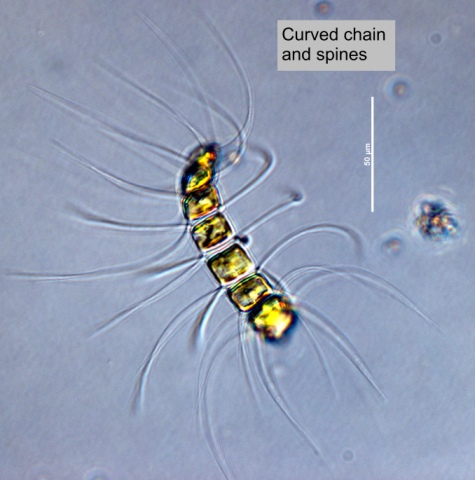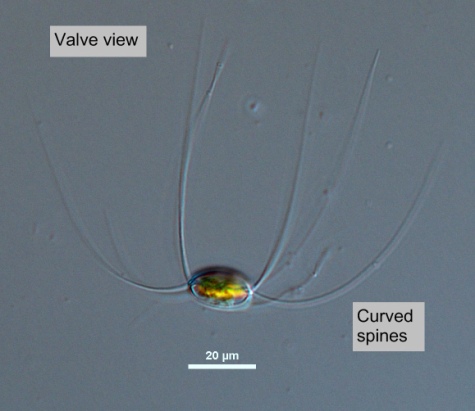



|
Synonym(s)
Heterotypic
A difference in type. In naming species, a heterotypic synonym is one that comes into being when a taxon becomes part of a different taxon. Compare to homotypic.
(heterotypic)(Guiry and Guiry 2012)
*Sometimes referred to as C. debile (Guiry 2012).
Classification
(Guiry and Guiry 2012)
Lifestyle
Description
Girdle
In diatoms, the portion of the cell wall between the two valves of a cell; made up of intercalary bands (bands closest to the valves) and connecting bands (bands in the middle of the girdle). In dinoflagellates, the equivalent of a cingulum or transverse furrow (Horner 2002).
girdle view and connected in spiralling chains. CloseValve
In diatoms, the structurally distinct halves of the cell wall (Becker 1996).
Valves are flat or slightly convex (although the spines make it seem concave). CloseAperture
"In some diatoms, the space between the valves of adjacent cells in chains" (Horner 2002).
Apertures are narrowly oval and sometimes slightly constricted in the middle. Spines are thin and arise just within the CloseMargin
The outline or border that defines the shape of an organism or cell.
margins, crossing just outside their base and extending outwards from the spiral. One chloroplast per cell (Cupp 1943). Cells are yellow-brown in colour.Measurements
Apical
(axis, spine) The region of the apex or point. Refers to the most anterior point or region of the cell (HPP 2003).
(apical axis): 8 - 40 μmSmall diameter Close
Transapical axis
In diatoms, the longitudinal axis of the valve.
(transapical axis): 5 - 25 μmLength Close
Pervalvar axis
The axis through the centre point of the two valves of a frustule. This axis is perpendicular to the valve face.
(pervalvar axis): 6 - 20 μm(Kraberg et al. 2010)
Similar species
Harmful effects
Habitat
Distribution
Cosmopolitan, but mainly found in cooler to temperate regions (Hasle and Syvertsen 1997, Kraberg et al. 2010).
Present from spring to fall around Northern European seas, with highest abundance in the spring (Kraberg et al. 2010). An important contributor to spring blooms in NE Atlantic and in Arctic waters (Degerlund and Eilertsen 2010).
Often very abundant from late winter to spring off California, and sometimes from late fall to early winter (Cupp 1943). In some years, it has bloomed during the summer off the west coast of Vancouver Island (Harris et al. 2009).
Growth conditions
Nutrients
Various chemical substances that an organism needs for metabolism (i.e., to live and grow). These are usually taken up from the environment. Some examples include nitrate, phosphate, silica (for diatoms), iron, copper, etc. Some nutrients, like copper, are required for growth, but can also be toxic at high levels.
nutrient conditions, but does not grow well under iron- and silica-limited conditions (Hoffman et al. 2007).Environmental Ranges
Temperature range (°C): -1.894 - 29.365
Nitrate (μmol L-1): 0.056 - 24.783
Salinity: 18.564 - 35.565
Oxygen (mL L-1): 4.524 - 9.192
Phosphate (μmol L-1): 0.051 - 2.131
Close
Silicic acid
A general term to describe chemical compounds containing silicon, oxygen and hydrogen with a general formula of [SiOx(OH)4-2x]n. Diatoms polymerize silicic acid into biogenic silica to form their frustules (Azam and Chisholm 1976).
Silicate (μmol L-1): 1.153 - 50.314(OBIS 2012, cited in EOL 2012)
Bloom characteristics
References
Assmy, P., Henjes, J., Klaas, C. and Smetacek, V. 2007. Mechanisms determining species dominance in a phytoplankton bloom induced by the iron fertilization experiment EisenEx in the Southern Ocean. Deep-Sea Research I. 54: 340-362.
Cupp, E. E. 1943. Marine Plankton Diatoms of the West Coast of North America. University of California Press. Berkeley, California. 238.
Degerlund, M. and Eilertsen, H. C. 2010. Main species characteristics of phytoplankton spring blooms in NE Atlantic and Arctic waters (68 - 80° N). Estuaries and Coasts. 33: 242-269.
Encyclopedia of Life (EOL). 2012. Chaetoceros debile. http://eol.org/pages/912058/overview. Accessed 18 Mar 2012.
Guiry, M. D. 2012. Chaetoceros debilis Cleve, 1894. http://www.marinespecies.org/aphia.php?p=taxdetails&id=149219. Accessed 18 Mar 2012.
Guiry, M. D. and Guiry, G. M. 2012. Chaetoceros debilis Cleve. http://www.algaebase.org/search/species/detail/?species_id=37416. Accessed 18 Mar 2012.
Harris, S. L., Varela, D. E., Whitney, F. W. and Harrison, P. J. 2009. Nutrient and phytoplankton dynamics off the west coast of Vancouver Island during the 1997/98 ENSO event. Deep-Sea Research II. 56: 2487-2502.
Hasle, G. R. and Syvertsen, E. E. 1997. Marine diatoms. In: Tomas, C. R. (ed.) Identifying Marine Phytoplankton. Academic Press, Inc., San Diego. 5-385.
Hoffman, L. J., Peeken, I. and Lochte, K. 2007. Co-limitation by iron, silicate, and light of three Southern Ocean diatom species. Biogeosciences Discussions. 4: 209-247.
Horner, R. A. 2002. A Taxonomic Guide To Some Common Phytoplankton. Biopress Limited, Dorset Press, Dorchester, UK. 200.
Kraberg, A., Baumann, M. and Durselen, C. D. 2010. Coastal Phytoplankton: Photo Guide for Northern European Seas. Verlag Dr. Friedrich Pfeil, Munchen, Germany. 204.
Ocean Biogeographic Information System (OBIS). 2012. Chaetoceros debilis. http://www.iobis.org/mapper/?taxon_id=419570. Accessed 18 Mar 2012.
